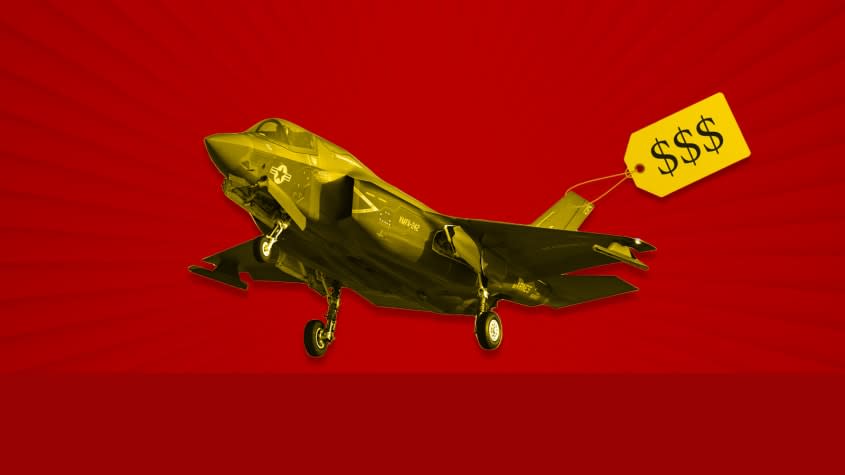The F-35 fighter jet's troubled history

America's F-35 jet fighter is running into problems again. Bloomberg reports that production of the plane has "marred by excessive defects and rework" that have reduced U.S. military readiness even though Lockheed Martin has already built and delivered more than 800 of the jets. It's yet another in a series of setbacks that have plagued the fighter since it first entered production in 2006. The program has been "dogged by bad news," The New York Times reported in 2019, raising all kinds of questions about the effectiveness and costs of the Pentagon's weapons-development process. (National Interest labeled the jet "the most expensive weapon system in human history.) Why does the F-35 have such a troubled history? And what does it mean for American air superiority? Here's everything you need to know:
What is the F-35's mission?
"The F-35 was billed as a fighter jet that could do almost everything the U.S. military desired," Michael P. Hughes writes for The Conversation. The plane was designed for the Air Force, Marines, and Navy, as well as international clients like Britain, Italy, Norway, and Canada. (The American Legion's website once labeled it "The free world's fighter jet.") It was expected to replace earlier generations of fighter jets like the Air Force's F-16 and the Marines' Harrier jump jets. It was expected to be stealthy. It was supposed to be cost-effective. And it was expected to be light years ahead of anything that America's rivals could produce. The problem: "It's turned out to be none of those things."
When did the F-35's problems start?
Right from the beginning. The Vanity Fair's Adam Ciralzky reported in 2013 that the Joint Strike Fighter program was launched in 2001 with a plan to put entire squadrons of planes in the air by 2010, at a relatively paltry cost of $233 billion. More than a decade later, however, the plans were "at least seven years behind schedule and plagued by a risky development strategy, shoddy management, laissez-faire oversight, countless design flaws, and skyrocketing costs." Three years after that the project's cost had doubled from its original estimates, and CNN reported that late Sen. John McCain decried the plane's development as "a scandal and a tragedy with respect to cost, schedule, and performance." And those problems continue right up through the present moment. Even now, Business Insider reports the F-35 "still hasn't been approved for full-rate production and remains in limited procurement.
So what are the problems?
Where to start? Here's a short list. The F-35 has been troubled by "problems with its stealth coating, sustained supersonic flight, helmet-mounted display, excessive vibration from its cannon, and even vulnerability to being hit by lightning," Business Insider reports. (The irony? The F-35's official nickname is the "Lightning II.") There have even been troubles building a simulator for pilot training. Because of issues with the jet's tail section, the Pentagon has limited how long the aircraft can fly at supersonic speeds — only short bursts of power are allowed. "The problem may make it impossible for the Navy's F-35C to conduct supersonic intercepts," Defense News reported in 2020. The program has also been plagued by a lack of spare parts for its $12 million engines: In February 2022, The Drive reports, "36 of the fleet of about 450 F-35s — or about 8 percent — were unable to fly because they had no working engine." In August, the Pentagon temporarily paused fighter deliveries because it discovered a Chinese-made part was used in production. And in December, deliveries were paused again after an F-35 crashed in Texas. (The pilot safely ejected.)
How much does all this cost?
A lot. The F-35 "remains DOD's most expensive weapon system program. It is estimated to cost over $1.7 trillion to buy, operate, and sustain," the Government Accountability Office reported in April. As of 2018, the New York Times reported, "flying an F-35A cost about $44,000 per hour on average — about double the cost of operating the Navy's Boeing F/A-18E/F Super Hornet."
But that doesn't reflect the entire expense. In a separate report in December 2022, the GAO pointed out that the Air Force and Navy have both increased their budgets to refurbish decades-old fighters like F-16s and F-18s to keep pilots in the air. But that affects military readiness, the agency warned: "DOD's tactical aircraft capacity — the size of its force available to meet operational demands — can be adversely affected by extended periods of aircraft depot maintenance and aircraft retirement."
Why not cancel the program, then?
That's hard to do — militarily, economically, and politically. At 1945, Brent Eastwood suggests it is an "inopportune time" to shut down the F-35 while Russia and China are fielding their own stealthy fighter jets. Canceling the program would cost thousands of jobs at Lockheed Martin, and it would be hard to accomplish politically. When then-President-elect Donald Trump fumed about the F-35's cost overruns in 2016, "Senators John Cornyn and Ted Cruz plus Representatives Marc Veasey and Kay Granger went to work lobbying the White House to leave the F-35 intact."
What's next?
Bloomberg reports the F-35 faces "a key combat simulation by mid-year" — already years past due — that will simulate the fighter's effectiveness "against the most advanced threats posed by Chinese and Russian aircraft and air defenses." The Navy Times reports the F-35 has to complete the test before "the F-35 Joint Program Office to move the fighter into full-rate production."
You may also like
5 entertaining cartoons about Biden's State of the Union address
United Airlines flight plunged to within 800 feet of Pacific Ocean

